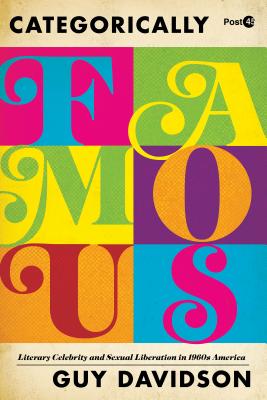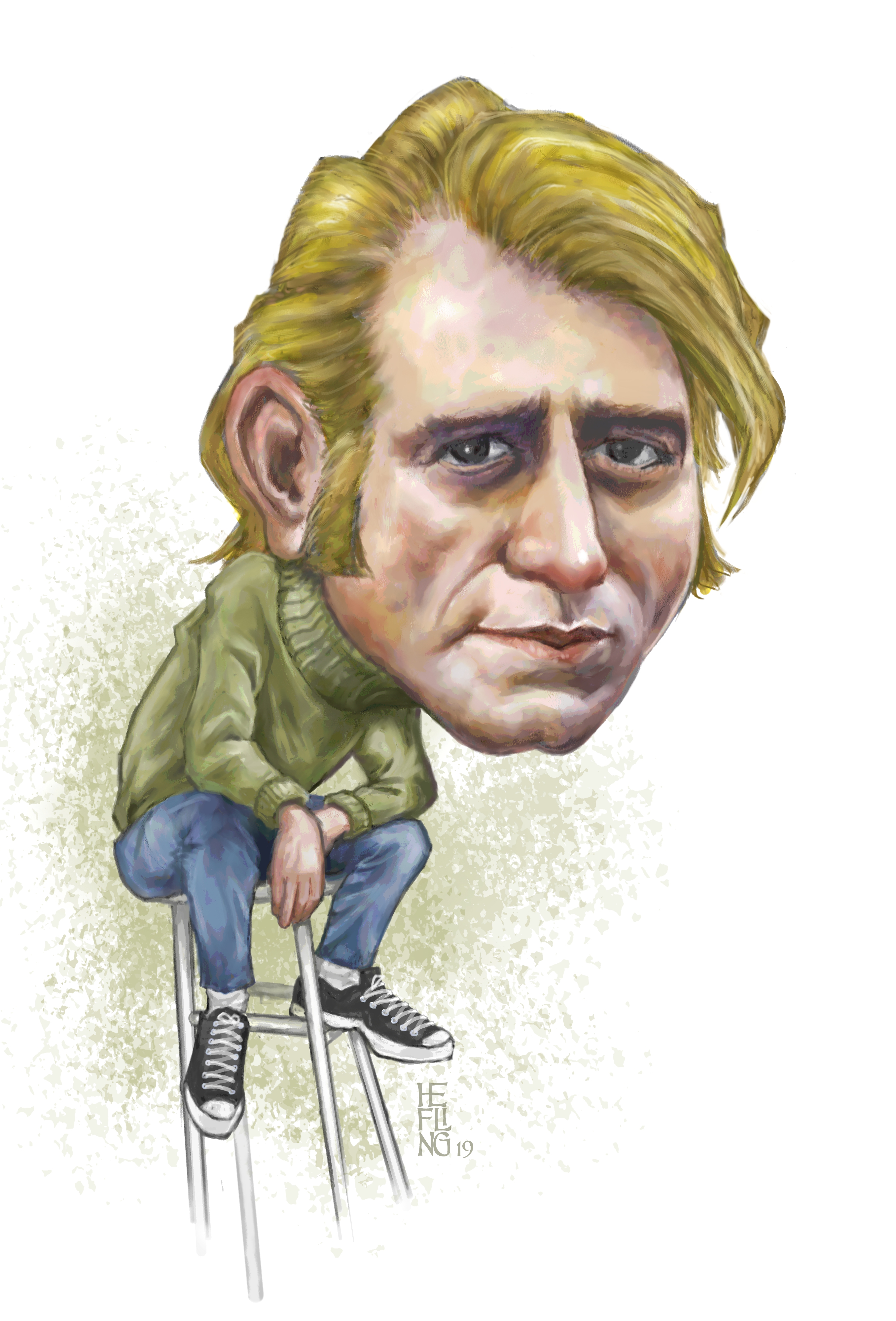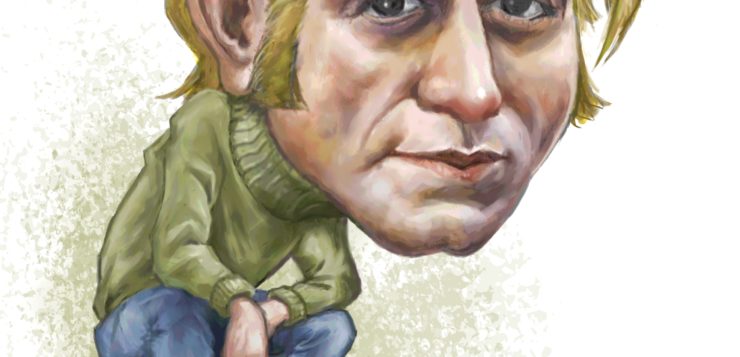 Categorically Famous: Literary Celebrity
Categorically Famous: Literary Celebrity
and Sexual Liberation in 1960s America
by Guy Davidson
Stanford Univ. Press. 227 pages, $30.
 A Voice of the Warm: The Life of Rod McKuen
A Voice of the Warm: The Life of Rod McKuen
by Barry Alfonso
Backbeat. 256 pages, $29.95
GUY DAVIDSON, a professor at the University of Wollongong (about an hour south of Sydney), begins his book about James Baldwin, Susan Sontag, and Gore Vidal with another American writer: John Cheever. In 1992, during an episode of Seinfeld called “The Cheever Letters,” George Costanza learns that the father of his fiancée Susan had once carried on a correspondence with the famously closeted author of Falconer, who resisted not only public awareness but also self-knowledge of his homosexuality until late in life.
Baldwin, Sontag, and Vidal refused to come out as well, but their sexuality was always what Davidson calls an “open secret.” And yet, Davidson says in the introduction to this fascinating study of 1960s culture: “If Cheever has become a byword for the dramatic move from the closet to visibility that liberation entails, these three writers, I suggest, manifest proto-visibility during the decade in which liberation emerged.”
Proto-visibility means their homosexuality was visible before homosexuality itself could be acknowledged publicly—which is why Davidson devotes an entire chapter to the shock when William F. Buckley called Gore Vidal a “queer” on network television while the two were covering the 1968 Democratic presidential convention. To be fair, Vidal had just called Buckley a “crypto-Nazi,” but the actor Paul Newman, a friend of Vidal, went to Buckley afterwards and pointed out that Vidal’s accusation was political, while Buckley’s was personal. Davidson’s book is about the way, during the decade before Stonewall, these two concepts began to merge, and how all three of his writers had to dance, as if on hot coals, in the dwindling space between the two.
Buckley’s eruption was, in Davidson’s eyes, a key moment in the evolution of Americans’ confrontation with homosexuality. According to scholars he cites, sexual mores in the United States began to loosen in the 1940s and ’50s, but it wasn’t till the ’60s that they became “mediatized.” It was during this period of transition that Baldwin, Sontag, and Vidal built their careers—which may explain why, when you watch Vidal insult Buckley, or Baldwin argue with a fellow guest on The Dick Cavett Show (both available on YouTube), you see how armored, how combative, these writers with an open secret had to be.
Davidson gives each writer two chapters. Baldwin’s chapters center on his novels Giovanni’s Room and Another Country, Sontag’s on her essay “Notes On ‘Camp,’” and Vidal’s on Myra Breckenridge and the television brawl with Buckley. Through all of them run the same themes: these writers’ refusal to leave the closet even as they consolidated their fame “through their representation and embodiment of sexual daring.”
 Baldwin, for instance, claimed that his agent told him to burn the manuscript of Giovanni’s Room because of its homosexual content (a claim she denied), but he went ahead with it because, as he said later, “If I hadn’t written that book I would probably have had to stop writing altogether.” And yet, when the Black Panther leader Eldridge Cleaver accused Baldwin of sexual degeneracy in his 1968 memoir Soul on Ice, instead of challenging him, Baldwin wrote that Cleaver had unfairly confused him “with the unutterable debasement of the male—with all those faggots, punks, and sissies, the sight and sound of whom, in prison, must have made him vomit more than once”—finessing the issue of his own sexual orientation by throwing other homosexuals under the bus.
Baldwin, for instance, claimed that his agent told him to burn the manuscript of Giovanni’s Room because of its homosexual content (a claim she denied), but he went ahead with it because, as he said later, “If I hadn’t written that book I would probably have had to stop writing altogether.” And yet, when the Black Panther leader Eldridge Cleaver accused Baldwin of sexual degeneracy in his 1968 memoir Soul on Ice, instead of challenging him, Baldwin wrote that Cleaver had unfairly confused him “with the unutterable debasement of the male—with all those faggots, punks, and sissies, the sight and sound of whom, in prison, must have made him vomit more than once”—finessing the issue of his own sexual orientation by throwing other homosexuals under the bus.
In truth, Baldwin did not think much of other homosexuals. “These people,” he said in a 1969 interview, “are not involved in anything resembling love-making: they’re involved in some kind of exhibition of their disaster.” Baldwin, like Vidal, suffered from what Davidson calls “effeminaphobia”—a distaste for screaming queens. In Vidal’s case, that would be Truman Capote; in Baldwin’s, the nelly patrons of a gay bar in Paris described in Giovanni’s Room, or the vignette of two homosexuals walking through Washington Square in Another Country.
Neither Giovanni’s Room nor Another Country could be said to contain a positive view of the gay life that was taking shape in the U.S. after World War II. And Baldwin was burdened by the fact that he was seen as an African-American spokesman for civil rights. But because of his physical oddness, the very way he held a cigarette on TV, he was seen to exemplify the effeminacy he disparaged. Like Truman Capote, he could not possibly be straight.
Sontag was another matter. By the time “Notes on ‘Camp’” came out, she’d been married to a man and produced a son, so nobody questioned her heterosexuality—except the gay men who knew how deeply indebted she was to her gay friends for the essay. It was the clutter she saw in the Parisian apartment of an American homosexual, Elliott Stein, and the witty persona of writer Alfred Chester that had inspired “Notes on ‘Camp’” in the first place.
Sontag’s essay was published in Partisan Review, the journal of the so-called New York Intellectuals, the only group to which Sontag wanted to belong. When it was picked up by the mass media, the sudden celebrity shocked her. She wrote “Notes on ‘Camp’” for Lionel Trilling, she later explained, so he’d stop thinking about Matthew Arnold. But once she became famous, the writer who became the “Dark Lady of American Letters” was not about to be reduced to a lesbian. She even took Baldwin to task in her review of Blues for Mister Charlie for pretending that his play was about race when really it was about “the anguish of tabooed sexual longings.” “The surface may be Walt Odets,” she wrote, in a line that seems to throw another homo under the bus, “but the interior is pure Tennessee Williams.”
Watching all three writers portray homosexuality while refusing to come out makes Davidson’s book a history whose drama not even the deadly jargon of Queer Theory can suffocate. Vidal is probably the most entertaining of the three. He was certainly the most daring, and not just because of The City and the Pillar and Myra Breckenridge, whose chutzpah astounds even today. Vidal claimed that there was no such thing as a homosexual, only homosexual acts. He cited the ancients’ belief that everyone is bisexual by nature. He further distanced himself from homosexuality by claiming that he never had sex with Howard Austen, his lifetime partner, that he always paid the people with whom he had sex, and that he never got fucked or sucked a cock. For Baldwin, “homosexual was not a noun.” Sontag did not have her “sexual reawakening” until she went to Paris in 1958, when her marriage was in trouble, and resumed a relationship with a woman she’d first had sex with at Berkeley as a sixteen-year-old. None of them wanted to be branded as a homosexual. When the editor of ONE, the magazine of the Mattachine Society, solicited prominent writers for an essay that would help his publication, it was Norman Mailer who sent him something.
Davidson has chosen these three writers as examples of the way the open secret of their sexuality made possible the opening of the closet door—though there were of course other people in the U.S. who were increasing the visibility of homo- sexuals in the 1960s. There was even what we might call the proto-audibility of Truman Capote, who was, Tennessee Williams said, “the founding father of the uncloseted gay world.” (Vidal said the “Tiny Terror” sounded like a Brussels sprout, if a Brussels sprout could talk.) But there were also the campy personæ of lesser lights like Liberace and Paul Lynde, and literary greats like Tennessee Williams, who was increasingly equated with homosexual decadence by the mainstream media as his career petered out.
On a less exalted level, there was Rod McKuen. In a short but comprehensive new biography by Barry Alfonso, we learn that McKuen adopted a strategy exactly like Vidal’s. “I don’t consider myself as being of any particular sexual persuasion,” the author of Listen to the Warm told Saturday Review in a 1972 interview. “I think the straights, gays and bi’s,” he told The Advocate four years later, “all do themselves a tremendous disservice by putting themselves into any kind of category.”
Was it something in the water? Or the fact that Senator Joseph McCarthy’s witch hunt for homosexuals in the federal government was still fresh in everyone’s memory? Or Freud’s advice to an American mother who was worried about her son that homosexuality, while no vice, was certainly no advantage. Whatever the reason, not only did McKuen refuse to reveal that he was a same-sexer while living with a lifelong male partner in Los Angeles, he claimed he had a son and daughter—whose existence Alfonso could find no evidence for. (Walt Whitman told John Addington Symonds that he had five children when Symonds tried to get the Good Gray Poet to admit that he was a “Uranian.”) Whitman, McKuen, Baldwin, Sontag, and Vidal (not to mention Proust, who challenged a journalist who alleged he was an invert to a duel) were undoubtedly responding to the same thing: being categorized in a way that would have threatened their literary careers by reducing the universality of their art. But it was also, one suspects, something that Davidson uses to interpret Baldwin’s work: shame.
Of course it wasn’t all denial. Even when dancing around the Awful Truth, these writers said some very enlightened and humane things. McKuen: “It’s not who you love or how you love but that you love.” Sontag, late in her career, told The New Yorker: “That I have had girlfriends as well as boyfriends is what? Is something I never thought I was supposed to say since it seems to me the most natural thing in the world.” One sees this in contemporary culture as well. Much has happened between Rod McKuen’s era and the present, but when Steve Lacy, a member of the band The Internet, answered on Tumblr the question of whether he was gay or straight, it was with a demurral that brings to mind McKuen: “I’m human.” Or, as Lacy put it on Twitter: “Let’s delete the whole closet concept and just let kids be themselves without having to announce what/who they’re into sexually.”
THIS UTOPIAN VISION of a world in which sexual orientation does not matter “has been a long time coming,” Davidson writes, “given that Freudian radicals intimated it in the 1950s and 1960s, that gay and lesbian liberationists were looking forward to it in the early 1970s, and that Queer Theory has been imagining it since the early 1990s.” But the persistence of the closet is shown, paradoxically, by the fact that “its purchase has expanded beyond same-sex sexuality to include a panoply of diverse identifications (trans, intersex, genderqueer, etc.).”
One cannot read Categorically Famous without reflecting on the way that language is used to deal with difficult subjects—how the terms for homosexuals, or people of African descent, have changed over the years, as if the subject is still so discomfiting that each generation must put on a different pair of gloves to refer to them. To have gone from queer to gay and back to queer, from colored people to African-Americans to people of color, betrays at the very least a certain uneasiness. The latest entry in this linguistic fashion parade, of course, is the non-binary, gender-fluid’s refusal to use “he” and “she” in favor of “they” and “them”—which is a development that Davidson addresses in his afterword.
Davidson’s argument, after the merciless light he has shone on the contradictions and evasions of his three subjects during the 1960s, goes something like this. The “proto-visibility” of Sontag, Baldwin, and Vidal led to a gay liberation that was based on homosexuals coming out of the closet, because that, it was thought, was the only way same-sexers could live freer, less persecuted lives; and while this turned them into a sort of gay “ethnic group,” this was necessary for liberation. Post-gay culture, however, finds the category “gay” confining. The list of celebrities who came out in 2017 as posted on the LBGT website Newnownext, Davidson notes, includes the categories gay, bisexual, lesbian, queer, trans, and intersex. On the website takepart.com he finds a listicle titled “Young Celebs Who Won’t Be Defined by Strict Notions of Sexuality.” “I don’t like labeling myself, or anyone else,” actress Natalia Morales says. “But if it’s easier for you to understand me, what I’m saying is that I’m queer. What queer means to me is just simply that I’m not straight. That’s all.”
By the time Davidson reaches the end of Categorically Famous, we have come full circle. The category that led the liberation movement is now a bit musty. Being gay is no longer transgressive, cutting edge, or even romantic; attention has shifted to the transgender movement, and the nonbinary. Judith Butler, the doyenne of Queer Theory, claims that “the discourse of ‘coming out’ has clearly served its purposes.” Another scholar, Peggy Phelan, goes further. Phelan “wants to bring to light ‘the power of the unmarked, unspoken, and unseen’ that visibility politics ‘erases.’” Butler calls this the “new opacity,” which may be a positive step, in her view, because gayness “now takes on a life that cannot be, can never be, permanently controlled,” which means it might instead become “rallying points for a certain resistance to classification and to identity as such.” But, Davidson asks, “does ‘a life that cannot be, can never be, permanently controlled’ look feasible, let alone politically meaningful?”
Which I guess means: Can the invisible participate in politics? Some will see the option of refusing to be labeled as an expansion of the inclusiveness that gay liberation worked for; others—like a friend whose university now requires everyone to choose a pronoun (he, she, they, them)—as a distraction from more important issues, a kind of narcissistic nonsense.
Generations are always defining themselves against their elders, and now that gay life appears to have been domesticated, new forms of resistance may seem necessary. But there’s an uncanny resemblance between the new refusals to be called gay and the way that Sontag, Vidal, and Baldwin danced around the matter, leading one to wonder: just what is being avoided by these refusals to be categorized? What is the stinking corpse in the garden? All these permutations of vocabulary seem to be an attempt to hide something. But what? In the case of Sontag, Vidal, and Baldwin, it was same-sex attachment. The new categories seem to refuse a fixed location altogether. But Categorically Famous does not dwell on this. Whatever the function of the word “gay” (which is clearly giving way to “queer” at this point), or the desirability of the New Opacity (which sounds like a line of cosmetics), Davidson is confident that coming out in whatever category, via whatever medium—now that literature has lost the centrality it once had—contributes to “both public understanding and individuals’ lived experience of LGBT identities.”
Andrew Holleran is the author of the novelsDancer from the Dance, Nights in Aruba, The Beauty of Men, andGrief.






